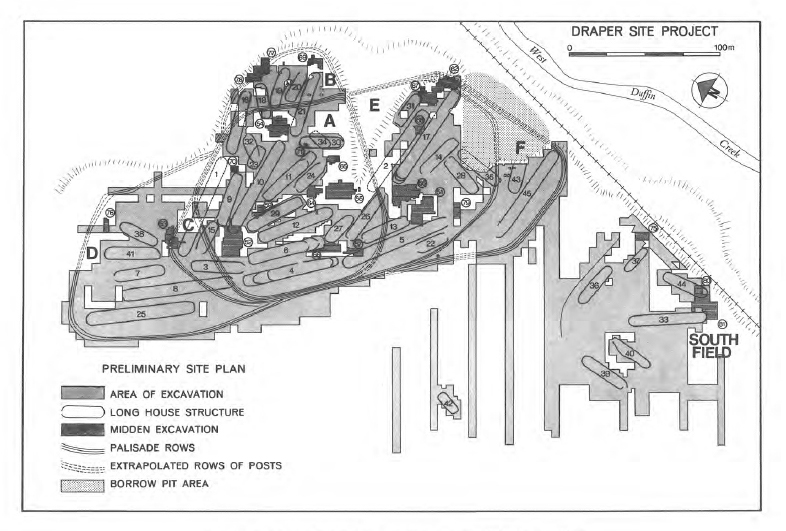We discovered 7 houses about 40 metres south of the Draper Main Village. Two of these houses overlapped, with one being shorter. I believe the latter may have been lived in by the workers who built the rest of the houses. There was eventually a total of 6 houses separated from the Main Village by a fence, and likely occupied at the same time.
One of the challenges has been trying to determine the exact relationship of these 6 houses to the Main Village. We have not been able to fully investigate this since the initial study of the pottery vessel fragments recovered from this part of the site was never completed in a satisfactory manner. As a result, we have to use the nature of the houses themselves in order to gain preliminary knowledge of this site.
In 1985, I published a 600-page book describing the houses, special structures, and palisades that we discovered during our excavations at the site in 1975, 1977, and 1978.
In describing the houses in the South Field, I noted a number of differences compared to the houses in the Main Village. These included an absence of village planning, unlike what we found in the Main Village, as well as a lack of defensive planning in the placement of the houses and absence of a palisade surrounding the houses. I also observed that the houses in the South Field were not as long as those in the Main Village. There were other unique features, such as the presence of well-defined rows of bench supports which provided the structural support for the sleeping platforms and the rafters of these houses. The shapes of the pits varied considerably too; and were dug into the floors of the houses and used for a variety of purposes, most of which remain unknown to us. The post moulds which defined the walls of these houses were also not as systematically placed as those in the Main Village. As outlined in my last blog, you will realize that the houses in the South Field at Draper were similar in many ways to those from the White site. These similarities have been recognized for the past 40 years and still require explanation.
If the South Field houses represent a seasonally occupied hamlet like the White site, I am now inclined to suggest that they could have been inhabited seasonally by the people who lived at the Spang village, the site occupied after Draper.
In order to further pursue, we really need to complete the analysis of the pottery from the South Field houses, as well as the plant and animal remains recovered from both sites. Only once this is completed will we understand the relationship of these two likely seasonally occupied hamlets to the major villages such as Draper and Spang. Unfortunately, funds for this kind of research are limited, and this remains a problem for a future generation of archaeologists to tackle.
Many mysteries remain, although we press on, elated when we uncover another piece of the puzzle.
I look forward to sharing more soon.
Sincerely,
Bill
William D. Finlayson, Midland, Ontario
Ontario’s Leading and Senior-Most Archaeologist and Author
Founder of Our Lands Speak Book Series and Occasional Papers in Ontario Archaeology
Feature image: 75 & 78 Excavations Site Plan
All rights reserved. The use of any part of this publication reproduced, transmitted in any form or by any means, electronic, mechanical, photocopying, recording, or otherwise, or stored in a retrieval system, without the prior written consent of the author and publisher is an infringement of the copyright law. To that end, every attempt has been made to give proper acknowledgement, and access appropriate permissions for quotes. Any oversights are purely unintentional. In the unlikely event something has been missed, please accept our regret and apology, and contact us immediately so we can investigate and rectify as needed. All of the quantitative factual information is recorded in various published and unpublished sources and can be provided upon request.
